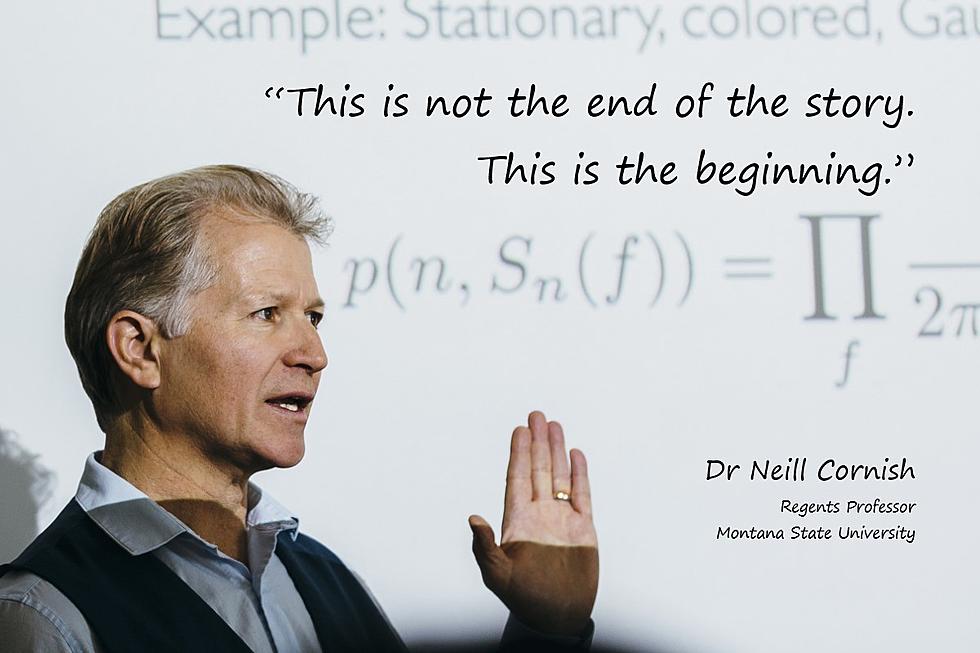
Einstein Was (Probably) Right: MSU Prof’s Work Supports Gravitational Waves Research
BOZEMAN – Using large radio telescopes to observe a collection of pulsars that act as cosmic clocks in our galaxy, a group of astrophysicists including Montana State University Regents Professor Neil Cornish has found evidence for low-frequency gravitational waves that oscillate with periods of years to decades, according to a set of papers published Wednesday in The Astrophysical Journal Letters.
The gravitational wave signal was observed in 15 years of data acquired by the North American Nanohertz Observatory for Gravitational Waves (NANOGrav) Physics Frontiers Center, a collaboration of more than 190 scientists from the U.S. and Canada who analyze the radiation emissions of pulsars, which are rapidly rotating neutron stars. It’s all part of the search for evidence of gravitational waves.
Earlier results from NANOGrav uncovered an enigmatic timing signal common to all the pulsars observed, but that signal was too faint to reveal its origin. The new data, however, demonstrate that the signal observed by NANOGrav is consistent with slowly undulating gravitational waves passing through our galaxy. Scientists believe that as they learn more about their origin, it could give them insights into the universe’s origin, structures and dynamics.
“This is the first compelling evidence for very low frequency gravitational waves, and it’s very much a cosmological kind of discovery,” said Cornish, who serves as director of MSU’s eXtreme Gravity Institute in the Department of Physics in the College of Letters and Science.
Cornish has been part of NANOGrav since 2013. He and former MSU doctoral student, Bence Bécsy, led the search for individual black hole binaries, which are systems consisting of two black holes in close orbit around each other and whose interactions are believed to generate gravitational waves. Cornish and Bécsy, along with MSU postdoctoral fellow Matthew Digman, are among the scientists who analyzed NANOGrav data and authored some of the scientific papers released this week. Cornish also serves on the NANOGrav internal review team, which is led by one of his former students, Tyson Littenberg.
Cornish said the new NANOGrav detection also validates a mathematical prediction about the effect of gravitational waves that was made in 1983 by a Montana State alumnus, the late Ron Hellings. At the time of his prediction, Hellings worked at NASA’s Jet Propulsion Laboratory, but he earned his doctorate at MSU in the 1970s and returned to the university in 2001 as a research professor in the physics department.
“I think it’s cool that there is a pretty significant MSU presence in this, including the very critical contribution that Ron Hellings made a long time ago,” Cornish said.
A wave period is the time it takes for a wave to complete one full cycle. Unlike the fleeting high-frequency gravitational waves detected in a fraction of a second by ground-based instruments, the continuous low-frequency signals detected by NANOGrav could be perceived only with a detector much larger than the Earth. To do this, astronomers turned our sector of the Milky Way galaxy into a huge gravitational-wave antenna by making use of pulsars. NANOGrav collected data from 68 pulsars to form a type of detector called a pulsar timing array.
“It’s a pretty wild detection method,” Cornish said. “This detector is thousands and thousands of light years across, so you couldn’t go out there and build it yourself. The only way we could do this was to use a pre-made network of pulsars that the universe was kind enough to provide for us. We just had to build the receivers here on Earth.”
Pulsars spin rapidly, sweeping beams of radio waves through space so that, when seen from Earth, they appear to pulse. The fastest of them, millisecond pulsars, spin hundreds of times each second. Their pulses are very stable, making them useful as precise cosmic timepieces.
Einstein’s theory of general relativity predicts precisely how gravitational waves should affect pulsar signals. By stretching and squeezing the fabric of space, gravitational waves affect the timing of each pulse in a small — but predictable — way, delaying some while advancing others. The gravitational stretching, Cornish said, amounts to a few hundred feet, a tiny measurement compared to the cosmic measurements involved. The squeezing and stretching creates a measurable pattern, a sort of coordinated “dance” between pairs of pulsars that depends on the angle between them as seen from our planet.
It was this concept that intrigued Ron Hellings and his colleague, George Downs, 40 years ago. Together they published a paper containing their mathematical calculation of what that effect would look like.
“It’s called the Hellings and Downs curve, and that is what we’ve been looking for,” Cornish said. “In our discovery paper, we actually show how we recovered that curve. It’s the absolute smoking-gun signature of the changes in the arrival times of these pulses being due to gravitational waves.”
NANOGrav’s most recent data set shows growing evidence for gravitational waves with periods of years to decades. Cornish said the next step is to determine exactly what is producing the signal.
“The most likely source, we think, are these supermassive black holes,” he said. “In the center of every large galaxy sits a very large black hole, typically billions of times the mass of the sun. When the galaxies merge, the black holes sink to the center, and we think they start orbiting around each other, producing gravitational waves and stirring up ripples in space-time. The level of signal we have – how loud it is – is right around what we would predict based on the merger rates of massive galaxies.”
Due to the length of time it takes black holes to complete their orbits, Cornish said, NANOGrav scientists have collected only a few cycles of gravitational waves so far. He said he is hopeful that by combining information from international data sets, some questions about the origins of the gravitational waves will be answered within the next five to 10 years.
“It’s almost like a generational activity – I liken it to cathedral-building,” he added. “Some of the pioneers like Ron aren’t even here to see the finished product. We’re going to keep going in the search and we’re going to keep working on the combined data sets very soon.
“This is not the end of the story – this is the beginning,” Cornish said.
- by MSU News Service -
More From KSEN AM 1150









